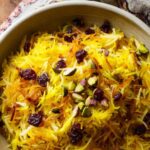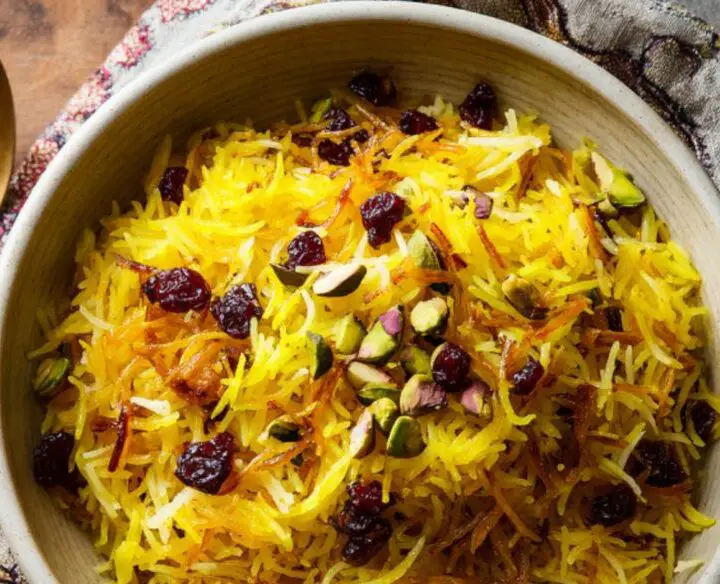Persian Saffron Rice with Barberries, known as Zereshk Polo, is a stunning and fragrant rice dish featuring golden threads of saffron, tart dried barberries, and buttery basmati rice, often garnished with pistachios. This elegant dish is a hallmark of Persian cuisine, served during both festive occasions and traditional family dinners.
Why You’ll Love This Recipe
This dish delights with its striking color, enticing aroma, and complex flavor profile. The floral warmth of saffron pairs perfectly with the tartness of barberries, creating a unique contrast that’s both vibrant and deeply satisfying. It’s naturally gluten-free, easily vegetarian, and makes any meal feel special. Whether paired with chicken, lamb, or served on its own, this rice is a centerpiece-worthy recipe.
ingredients
(Tip: You can find the complete list of ingredients and their measurements in the recipe card below.)
- Basmati rice
- Dried barberries (zereshk)
- Saffron threads
- Sugar
- Butter or ghee
- Onion, thinly sliced (optional)
- Slivered pistachios or almonds (optional for garnish)
- Salt
- Water
- Vegetable oil
directions
- Rinse the basmati rice in cold water until the water runs clear. Soak for 30 minutes, then drain.
- Bloom the saffron by grinding it and dissolving in a few tablespoons of hot water. Set aside.
- Cook the rice in salted boiling water until just tender (about 7–8 minutes), then drain and rinse under cold water.
- Heat oil in a non-stick pot and add a layer of rice to form a crust (optional tahdig). Add the remaining rice on top, drizzle with saffron water and some melted butter. Cover and steam over low heat for 30–40 minutes.
- While the rice steams, rinse the barberries and sauté in butter with a pinch of sugar and optionally, caramelized onions.
- Once the rice is ready, gently fluff and fold in the barberries or serve them layered or on top. Garnish with pistachios if desired.
Servings and timing
This recipe serves approximately 6 people. Total preparation and cooking time is around 1 hour, including soaking and steaming.
Variations
- With Chicken: Serve with saffron chicken or grilled lamb chops for a full meal.
- Herb Polo: Add chopped dill or parsley to the rice for an herbal touch.
- With Orange Peel: Include thinly sliced candied orange peel for a sweet note.
- Vegan: Use oil instead of butter or ghee.
- Almond Topping: Garnish with toasted almonds or walnuts for extra texture.
storage/reheating
Store leftovers in an airtight container in the refrigerator for up to 4 days. Reheat in a microwave or gently steam on the stovetop with a splash of water. This rice dish can be frozen for up to 1 month; thaw in the fridge and reheat thoroughly.
FAQs
What are barberries and where can I find them?
Barberries are small, tart dried berries used in Persian cooking. They are available in Middle Eastern or specialty grocery stores.
Can I substitute the barberries?
Cranberries or currants can be used, though the flavor will be sweeter and less tart.
What is tahdig?
Tahdig is the crispy golden rice crust formed at the bottom of the pot, considered a delicacy in Persian cuisine.
How do I bloom saffron properly?
Grind saffron threads and steep in hot water for 10 minutes to release color and aroma.
Can I make this dish ahead of time?
Yes, it can be made earlier and gently reheated before serving.
Is Persian rice gluten-free?
Yes, the ingredients are naturally gluten-free.
What kind of rice is best for this recipe?
Long-grain basmati rice is preferred for its fragrance and fluffy texture.
Can I make this dish without a non-stick pot?
Yes, but a non-stick or heavy-bottomed pot is ideal for forming tahdig.
Why soak the rice before cooking?
Soaking helps remove excess starch and ensures long, separated grains after cooking.
Is this dish spicy?
No, it is aromatic and tangy rather than spicy. However, you may add a touch of ground pepper if desired.
Conclusion
Persian Saffron Rice with Barberries is a vibrant and aromatic dish that elevates any meal. The floral richness of saffron and the zesty brightness of barberries combine to create a memorable culinary experience. Whether as a festive centerpiece or a sophisticated side dish, this traditional Persian recipe brings elegance and flavor to your table.
Print
Persian Saffron Rice with Barberries
- Prep Time: 15 mins
- Cook Time: 45 mins
- Total Time: 1 hr
- Yield: 4 servings 1x
- Category: Side Dish
- Method: Steamed
- Cuisine: Persian
- Diet: Halal
Description
Persian Saffron Rice with Barberries, or Zereshk Polo, is a traditional and aromatic Iranian dish made with fluffy basmati rice infused with saffron and topped with tart barberries sautéed in butter. It’s often served with chicken or lamb and is a staple of Persian cuisine.
Ingredients
- 2 cups basmati rice
- 1/4 teaspoon saffron threads, crushed
- 2 tablespoons hot water (for saffron)
- 1/2 cup dried barberries (zereshk)
- 2 tablespoons butter
- 1 tablespoon sugar (optional, to balance tartness)
- 1 teaspoon salt
- 2 tablespoons vegetable oil
- Water for boiling
Instructions
- Rinse rice several times until water runs clear. Soak in salted water for at least 30 minutes.
- Soak crushed saffron in 2 tablespoons hot water and set aside.
- Bring a large pot of water to a boil. Drain soaked rice and add to boiling water. Cook for 5–7 minutes or until al dente. Drain and rinse with cold water.
- In a non-stick pot, heat 2 tablespoons oil. Add a layer of rice to form a crust (tahdig), then layer the remaining rice on top. Cover the lid with a kitchen towel and place on the pot. Steam on low heat for 30–40 minutes.
- Meanwhile, rinse barberries and sauté in butter for 1–2 minutes. Add sugar if using and cook for another minute. Stir in saffron water and remove from heat.
- Once rice is done, fluff gently. Mix some of the saffron barberries into the rice or layer on top for serving.
Notes
- Use high-quality basmati rice for best texture and aroma.
- Barberries can be found in Middle Eastern or Persian grocery stores.
- The crusty bottom (tahdig) is a prized part of the dish—don’t skip it!
Nutrition
- Serving Size: 1 cup
- Calories: 320
- Sugar: 5g
- Sodium: 290mg
- Fat: 10g
- Saturated Fat: 4g
- Unsaturated Fat: 5g
- Trans Fat: 0g
- Carbohydrates: 52g
- Fiber: 2g
- Protein: 5g
- Cholesterol: 10mg


Your email address will not be published. Required fields are marked *